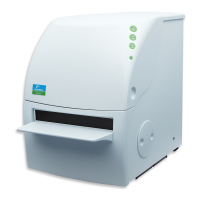Functional description
7
Functional description
This section contains information about the technical features of your
instrument such as supported assays and technologies, designs and
measurement features.
Application information
EnVision supports several kinds of assays.
Reporter gene assays
When you need to measure either the level of expression or the functional
effect of a drug candidate in terms of transcriptional activity of cells,
EnVision provides the features you need for reliable detection of reporter
gene expression.
The instrument has comprehensive and versatile scanning and kinetics
capabilities. It supports GFP assays with dual reading from below. You can
also measure, for example, Luciferase and B-lactamase in the same
protocol. Dual emission reading is possible for all technologies.
Enzyme assays
In Kinase, Protease, Helicases or Caspase assays, for example, EnVision
reads very rapidly using a two-detector system. The temperature control
option enables enzyme applications to be run in stabilized conditions. The
instrument's kinetics facility and, for example, its flexible stacker system
option, allow you to work fast and effectively.
Time-resolved fluorometry
DELFIA and LANCE assays are based on time-resolved fluorescence
methods using proprietary chelates from PerkinElmer. You can choose
DELFIA separation assays of extreme sensitivity, or fast and convenient
LANCE homogenous assays. PerkinElmer supply a wide range of reagents
or you can benefit from these superior technologies through our assay
service. EnVision also supports other TRF chemistries such as
LanthaScreen
™
and HTRF
®
Receptor ligand binding assays
One of the most common molecular targets for drug discovery are G
protein-coupled receptors (GPCR). Assays based on fluorescence
polarization provide today's most effective means of their detection. Fast-
reading EnVision is ideal, for example, for B2-Bradykin, MC3, MC4 and
MC5.

